About Norma Canner
The following biographical information was compiled by William C. Freeman, PhD, ADTR* and Anne Brownell, MA, LMHC**, VMTR***
For more information about them, visit at www.vmtusa.com
View Norma Canner's Resume
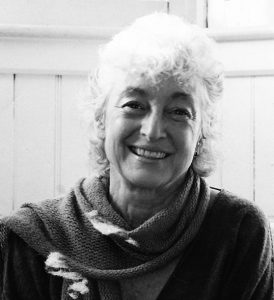
NORMA CANNER, Artist-Therapist
Norma G. Canner is both a distinguished and an inspired pioneer in Dance Movement Therapy, noted particularly for her early and significant contributions to working with children and youth with disabilities. After a career as an actress, Norma discovered creative dance with teacher and performer Barbara Mettler. Her own teaching and exploration subsequently led her into the field of Dance Therapy where she attained a national and international reputation for her innovative work using dance as therapy and for educating a generation of Expressive Arts Therapists. Norma is Professor Emerita, Lesley University, Cambridge, MA, and the author of "…and a time to dance," an inspiring, informative and deceptively simple book about the enrichment creative dance and movement can provide to children with special needs, written in 1974. In 1998, the feature-length documentary film, A Time to Dance: The Life and Work of Norma Canner, created to show the power of the Expressive Therapies using Norma’s work as a model, was premiered.
In the 1950’s, in Toledo, Ohio, Norma began her work with children with disabilities when moved to help a child with multiple sclerosis who came to her class at the YWCA to extend her range of motion through creative dance. Consultation with this child’s doctor led to work with more children with MS and with others experiencing a wide range of disabling conditions. At the Toledo State Hospital, Norma initiated a music and movement program for chronic schizophrenics who had been institutionalized for twenty-five years. The participants, even those in catatonic states, were able to give up their pathologies sufficiently during sessions with Norma to express themselves in group dances and to learn new socialization skills. She reflected this experience in her poem Toledo State Hospital: The Locked Ward.
In the 1960’s, Norma established a pilot program for the Massachusetts Department of Mental Health in movement and dance for pre-school children, which resulted in the emergence of fourteen statewide centers where pre-school teachers and aides received training in the dance modality. This program became a model for what we now know as Early Intervention and resulted in Norma’s book, "…and a time to dance," which became a handbook for others in the field. Norma also conducted dance movement workshops throughout the United States and Nova Scotia for Head Start teachers in community settings such as housing projects, museums, colleges, child development departments, the Massachusetts Association for Retarded Children, the Boston Association for the Education of Young Children, and the National Child Research Center in Washington, DC.
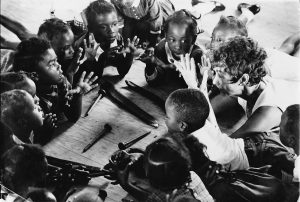 At the Belchertown, MA, State Hospital, she designed individual and group programs for non-hearing, non-verbal children which resulted in new training models for RN’s and aides using the principles originated in this program, and described in her article, A Program for Stimulating Vocalization in Children with No Speech.
At the Belchertown, MA, State Hospital, she designed individual and group programs for non-hearing, non-verbal children which resulted in new training models for RN’s and aides using the principles originated in this program, and described in her article, A Program for Stimulating Vocalization in Children with No Speech.
In 1974, after teaching at numerous colleges and universities, including: Tufts University, the Harvard Summer School, Boston University, and Wheelock and Simmons colleges, Norma originated the Dance Therapy Department at Lesley University where she taught for 13 years. In the course of her work there, she established a program, at Perkins School for the Blind, in which she and her students worked with multiply handicapped children, using dance and movement, musical instruments and sound to increase the mobility, confidence and sociability of the children, while at the same time expanding their sensory awareness and spatial concepts. During this period, she also conducted training workshops in the United States, Canada, Europe and Israel.
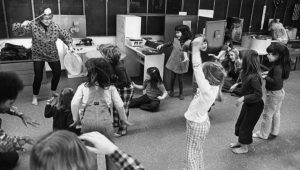 In 1981, Norma started traveling to Kansas where she became the first out-of-state consultant for a program for the Kansas State Board of Education, now known as Accessible Arts. Each year, for more than a decade, Norma came to Kansas to teach teachers, therapists, artists and parents how to use dance and the expressive arts with children and youth with disabilities. She consulted on two projects funded by the United States Department of Education and, in addition to her training work, gave innumerable hours of her time to further the development of this program, creating a sense of community wherever she went. In her travels in the most rural areas of Kansas, Norma was always a hit, just as she is in more sophisticated urban environments. She honors each person and their values. Her easy way of being with others fosters trust, play, creativity and the expression of deep feelings, even among those you’d bet would never take the risk.
In 1981, Norma started traveling to Kansas where she became the first out-of-state consultant for a program for the Kansas State Board of Education, now known as Accessible Arts. Each year, for more than a decade, Norma came to Kansas to teach teachers, therapists, artists and parents how to use dance and the expressive arts with children and youth with disabilities. She consulted on two projects funded by the United States Department of Education and, in addition to her training work, gave innumerable hours of her time to further the development of this program, creating a sense of community wherever she went. In her travels in the most rural areas of Kansas, Norma was always a hit, just as she is in more sophisticated urban environments. She honors each person and their values. Her easy way of being with others fosters trust, play, creativity and the expression of deep feelings, even among those you’d bet would never take the risk.
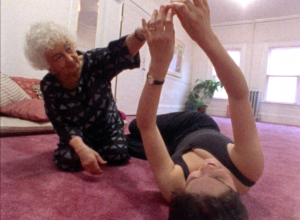 In the mid-eighties to the present, Norma maintained a private practice with adults, as a psychotherapist using the dance modality. Her eclectic approach combined dance and movement with imagery, sound, voice and enactment, to encourage a full expression and integration of the self. She employed Jungian, Gestalt and developmental theories in working with the imagination, dreams, and social relationships; Authentic Movement and Neo-Reichian approaches for bodywork and body awareness; and, perhaps most importantly, her own sensory-based and heart-centered ability to find the hurt or frozen child inside of individuals of all ages and call him or her forth into creative play and transformation.
In the mid-eighties to the present, Norma maintained a private practice with adults, as a psychotherapist using the dance modality. Her eclectic approach combined dance and movement with imagery, sound, voice and enactment, to encourage a full expression and integration of the self. She employed Jungian, Gestalt and developmental theories in working with the imagination, dreams, and social relationships; Authentic Movement and Neo-Reichian approaches for bodywork and body awareness; and, perhaps most importantly, her own sensory-based and heart-centered ability to find the hurt or frozen child inside of individuals of all ages and call him or her forth into creative play and transformation.
In 1992 and ’93, Norma developed a creative dance workshop in Kansas for teachers, artists and therapists which took place in a wilderness environment and focused on our place in and connection to the natural world. Through creative dance, song and other structured sensory experiences, participants explored the way place affects the very nature of the learning process and increased both their personal and group awareness of the integral connection between creativity and place. This experience was recorded in the film, Arts in the Environment: a Study of Group Process in the Natural World.
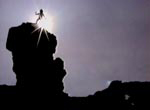 Norma is particularly interested in creating environments where people can expand their creative boundaries and discover their own dance through spontaneity and structures which validate what is unique to each and common to all.. In the 90’s, Norma also led creative movement and music sessions at Seton House in Alston, MA, for formerly homeless and substance abused people who were HIV-positive or had AIDS.
Norma is particularly interested in creating environments where people can expand their creative boundaries and discover their own dance through spontaneity and structures which validate what is unique to each and common to all.. In the 90’s, Norma also led creative movement and music sessions at Seton House in Alston, MA, for formerly homeless and substance abused people who were HIV-positive or had AIDS.
Norma began the twenty-first century with a creative dance project with a group of former students, now colleagues, in which they explored the theme of the grief of war and loss and the longing for peace. This resulted in The Bones of the Earth: A Work in Process, which was presented at the Conference for Body, Mind and Spirituality at Lesley University in 2000, as part of Norma’s keynote speech, and at the American Dance Therapy Conference in Burlington, NH, in 2002.
Throughout her Dance Therapy career of fifty-plus years, Norma has continued to innovate and experiment and to respond to the needs of people she meets, developing new approaches for working in the Expressive Arts Therapies, most notably through programs for the Lesley Expressive Therapy Graduate Schools in Cambridge, MA, and Israel; Accessible Arts in Kansas; and the European Graduate School in Switzerland where she taught most recently in the summer of 2003.
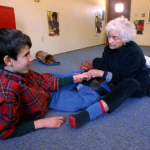 Many people have been profoundly affected by Norma and her belief in the power of dance and movement to be inclusive of all people and to touch deeply the human experience. Many have witnessed her work with children, their teachers and parents, and with adults whose previous life experience has separated them from their own creativity and sense of self-worth. Norma creates opportunities for individuals to discover the rich resources which lie within us all. Her innovative methodology illustrates her unique sensory-based approach which integrates dance, dramatic action, sound and visual expression to facilitate growth and change, and a renewed or perhaps new-found sense of joy and wonder, in both children and adults. In educational, artistic, therapeutic and clinical contexts, Norma’s work is profoundly simple, artistic, intuitive and well-informed.
Many people have been profoundly affected by Norma and her belief in the power of dance and movement to be inclusive of all people and to touch deeply the human experience. Many have witnessed her work with children, their teachers and parents, and with adults whose previous life experience has separated them from their own creativity and sense of self-worth. Norma creates opportunities for individuals to discover the rich resources which lie within us all. Her innovative methodology illustrates her unique sensory-based approach which integrates dance, dramatic action, sound and visual expression to facilitate growth and change, and a renewed or perhaps new-found sense of joy and wonder, in both children and adults. In educational, artistic, therapeutic and clinical contexts, Norma’s work is profoundly simple, artistic, intuitive and well-informed.
In making the film, A Time to Dance: the Life and Work of Norma Canner, Norma came to Vermont to work with children, their parents and teachers. She worked with Eric, a boy with autism and now, when anyone mentions Norma, Eric often says, "Movement therapy… I love Norma."
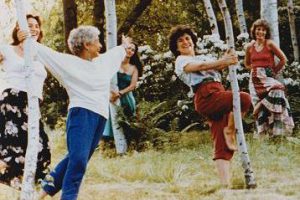 Norma is greatly loved by many of her colleagues, former students and clients as well as her family and friends. Her depth of feeling, compassion and artistry; her reverence for our sacred and only home, Planet Earth; and her commitment to a social and global consciousness that is able to respond to those in need, is an inspiration for all of us to grab on to our opportunities to affect positive change. Norma is, in essence, an artist-therapist: she is an artist of human relationships.
Norma is greatly loved by many of her colleagues, former students and clients as well as her family and friends. Her depth of feeling, compassion and artistry; her reverence for our sacred and only home, Planet Earth; and her commitment to a social and global consciousness that is able to respond to those in need, is an inspiration for all of us to grab on to our opportunities to affect positive change. Norma is, in essence, an artist-therapist: she is an artist of human relationships.
William C. Freeman, PhD, ADTR* and Anne Brownell, MA, LMHC**, VMTR***
* Senior Registered Dance Therapist
** Licensed Mental Health Counselor
*** Registered Voice Movement Therapist
Resume
Norma G. Canner, ADTR
Professor Emerita, Lesley University
865 Central Ave, Apt D308
Needham, MA 02496
Education
Creative Movement with Barbara Mettler……………………………………….1947-52
Dance Therapy with Marian Chace. Janet Adler and Anna Halprin……1959, ‘72 & ‘74
Studies in Humanistic Psychology; Alexander Technique; Effort Shape at the
Dance Notation Bureau, New York, NY; Seminar Exploring Techniques in
a Therapeutic Community, with Dr. Shephard Ginandes...........................................1975
Supervision under Dr. Ginandes…………………………………………………….1976
Studies in Jungian Psychology……………………………………………………...1977
Gestalt Therapy Training………………………………………………………..1979-80
Studies in Bioenergetics, Folklore, the Environment, Poetry, Dance, other…..to present
Professional Experience
Taught creative movement for children & adults in Toledo, Ohio at YWCA.
Jewish Community Center, Fred Douglas Center; worked w. adults w.
schizophrenia, Toledo State Hospital; lectured at nursery schools & at
Detroit Ballet Workshop…………………………………………………………1952-59
Taught workshops at Eliot-Pearson School, Tufts University, Medford, MA……......1960
Taught workshops for teachers of pre-school children with special needs,
Massachusetts Dept. Mental Health……………………………………………..1961-63
Teacher-consultant, creative movement with children & teachers; established
Dept. of Creative Movement, Mass. Dept. Mental Health……............................1961-63
Gave lectures & workshops in creative movement at Boston University
Graduate Schools of Nursing & Special Education, Eliot Pearson Dept. of
Child Study, Mass. Association of Retarded Children, Mississippi Head
Start,; Jamaica Plain Children’s Museum, Simmons, Lesley & Wheelock
Colleges; provided trainings for Special Education and Head Start teachers in
Lawrence, Lowell, Cambridge, New Bedford, Fall River, MA; University of
New Hampshire…………………………………………………………………1961-70
Faculty member, Supplementary Education Training Program,Wheelock
College; Child Study Program, Tufts University; Movement Consultant,
Enrichment Program, University of Mass; workshops & demonstrations:
Columbia University Teachers College; U. of California, California State
College; with young people in Juvenile Detention Center, Roslindale, MA……1961-73
Guest lecturer: demonstration & discussion with doctors at rounds for T.
Berry Brazelton, Children’s Hospital, Boston, MA………………………………...1973
Founding Director, Dance Therapy Dept. of Graduate Studies in Expressive
Therapies, Lesley College, Cambridge, MA…………………………………….1974-87
Workshops: Four Areas of Creative Movement for Normal & Special
Populations, Educational Arts Association Conference, Seattle, WA; Special
Education Dept, University of Connecticut; Midwestern Regional Dance
Therapy Conference; Orff Schulwork Association; Consultant in Child
Development Program, in-service program for Head Start teachers,
Psychodrama Institute, Boston, MA; Guest lecturer, Introduction to Dance
Therapy, Harvard University Summer School of Dance………………………1974-75
Taught Dance Therapy, Harvard Summer School of Dance…………...1971, ’75, ’76, ‘78
Guest lecturer, course in non-verbal communication, Harvard University………1976&78
Dance Therapy workshops: New England Regional Council for Blind-Deaf
Children; Massachusetts Dance Teachers of America; Massachusetts
Branch, National Association for the Handicapped; Lesley College
Graduate Programs, Israel & Switzerland……………………………………….1078-84
Consultant to Accessible Arts, a program of the Kansas State Board of
Education, teaching teachers, therapists, artists and parents how to use
Movement & the Expressive Arts with children w. disabilities…………………1981-94
Private psychotherapeutic practice using Dance Therapy modality and
providing supervision to practitioners………………………………..1984 to the present
Arts & the Environment Workshops for Accessible Arts, Kansas……………….184 & 85
Conducted sessions with formerly homeless and substance people who were
HIV-positive or had AIDS……………………………………………………….1995-98
Publications
Canner and Harriet Klebanoff, "…and a time to dance" Beacon Press, Boston, MA: 1968
Canner, ‘A Program for Stimulating Vocalization in Children Who Had No Speech,"
Journal for American Society of Psychopathology: 1970
Canner & Anne Brownell: "Going to the Source: Dance Movement Therapy and
The Creative Self," Arts w. Special Needs Students: Early Innovators, Accessible
Arts, Inc, Monograph, Kansas City, KS: 1997
Films
"…and a time to dance," film to accompany book of same title, Mass. Dept. Mental
Health: Boston, MA: 1967
Ripples: Body Talk & Touching the World, two films made by Northern Virginia
Educational Television which achieved national exposure:1970
Arts in the Environment: a Study of Group Process in the Natural World, (for Accessible Arts, Inc.), Bushy Theatre, Inc, Somerville, MA:1994
A Time to Dance: The Life and work of Norma Canner, feature-length documentary
shown in Boston, New York, D.C., film festivals in Maine and Vermont, and which
received the Gradiva Award in Film from the American Association of Psychoanalysis,
2001. Bushy theatre, Inc, Somerville, MA: 2000
Presentations
Guest Speaker & lecturer, "Year of the Child," New York University, New York, 1979
Keynote speaker: Notes from a Journal, Very Special Arts Conference, Boston, MA, 1986; Our Planet Earth, American Dance Therapy Association Annual Conference;
Dance and the Environment, Dance Umbrella, Cambridge, MA, WGBH Public Broadcasting; Going to the Source: Dance Therapy and the Creative Self, Marian Chase Lecture, American Dance Therapy Association Conference, Raleigh, NC, 2001
Keynote speech and dance performance: The Bones of the Earth: a Work in Process, Conference on Body, Mind & Spirituality, Lesley University, 2001 and American Dance Therapy Association Annual Conference, 2002.
Honors
Loretta Taft Lectureship, Dept.of Dance & Dance Therapy, University of Illinois,
Champagne, IL, 1974; honored for pioneering work at American Dance Therapy
Conference, Raleigh, NC, 2001; Marian Chace Award, American Dance Therapy
Annual Conference, 2002; European Graduate School Citation for Lifetime
Achievement in the Field of Expressive Arts Therapy, "In honor of her artistry,
devotion and grace: prima enter pares, 2003